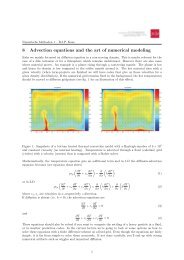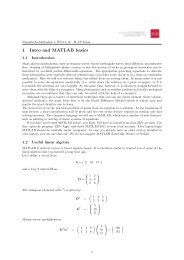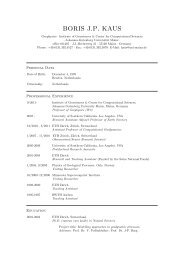Project: 2D Stokes equations and geodynamic deformation
Project: 2D Stokes equations and geodynamic deformation
Project: 2D Stokes equations and geodynamic deformation
You also want an ePaper? Increase the reach of your titles
YUMPU automatically turns print PDFs into web optimized ePapers that Google loves.
Numerische Methoden 1 – B.J.P. Kaus<strong>Project</strong>: <strong>2D</strong> <strong>Stokes</strong> <strong>equations</strong> <strong>and</strong> <strong>geodynamic</strong> <strong>deformation</strong>IntroductionThe basis of basically all mantle convection <strong>and</strong> lithospheric dynamics codes are the so called <strong>Stokes</strong><strong>equations</strong> for slowly moving viscous fluids. Here we will describe the governing <strong>equations</strong>. There areseveral ways to solve those <strong>equations</strong>, <strong>and</strong> the goal of this project is to use a staggered finite differenceapproach in primitive variables. In normal words: we solve the governing <strong>equations</strong> for v x , v z (velocities)<strong>and</strong> P (pressure). Staggered finite differences means that the different unknowns v x , v z , P are definedat physically different grid points. The main challenges of this project are (1) having several variablesinstead of only one (like e.g. temperature) <strong>and</strong> (2) do the bookkeeping for the present case that thevariables are at different grid points.Governing <strong>equations</strong>It is assumed that the rheology is incompressible <strong>and</strong> that the rheology is Newtonian viscous. In thiscase, the governing <strong>equations</strong> are (see equation cheat sheet):∂σ xz∂x∂v x∂x + ∂v z∂z∂σ xx∂x+ ∂σ zz∂z+ ∂σ xz∂z= 0 (1)= 0 (2)− ρg = 0 (3)σ xx = −P + 2µ ∂v x∂xσ zz = −P + 2µ ∂v z(∂z∂vxσ xz = µ∂z + ∂v )z∂xIt has been suggested that a particular nice way to solve these <strong>equations</strong> is to use a staggered grid(more about this later) <strong>and</strong> to keep as variables v x , v z <strong>and</strong> P . Since there are three variables, we needthree <strong>equations</strong>. Substituting eqns. 4-6 into 2 <strong>and</strong> 3 leads to:(4)(5)(6)− ∂P∂x + 2 ∂ (∂x− ∂P∂z + 2 ∂ ∂zµ ∂v )x+ ∂ (µ∂x ∂z(µ ∂v )z+ ∂ (µ∂z ∂x∂v x∂x + ∂v z∂z( ))∂vx∂z + ∂v z∂x( ∂vx∂z + ∂v ))z∂x= P γ(7)= 0 (8)= ρg (9)Note that we added the term P γto the incompressibility <strong>equations</strong>. This is a ’trick’ called the penaltymethod, which ensures that the system of <strong>equations</strong> does not become ill-posed. For this to work, γshould be sufficiently large (∼ 10 4 or so).Exercise1. Discretize the <strong>equations</strong> (7-9) on a staggered grid as shown on fig. 1.1
Numerische Methoden 1 – B.J.P. KausBoundary5/23/21/2-1/2Fictious boundary pointsFigure 2: Staggered grid definition with the boundary points. Within the purple domain, the finitedifference scheme for center points can be applied. At the boundaries around, we have to apply specialboundary finite difference scheme’s, which employ fictious boundary nodes to correctly set the boundary<strong>equations</strong>.3
Numerische Methoden 1 – B.J.P. Kaus%Staggered_<strong>Stokes</strong>%% Solve the <strong>2D</strong> <strong>Stokes</strong> <strong>equations</strong> on a staggered grid, using the Vx,Vz,P% formulation.%clear% Material properties% phase #1 phase #2mu_vec = [1 1 ];rho_vec = [1 2 ];% Input parametersNx = 20;Nz = .9*Nx;W = 1;H = 1;g = 1;% Setup the interfacex_int = 0:.01:W;z_int = cos(x_int*2*pi/W)*1e-2 - 0.5;% Setup the grids----------------------------------------------------------dz = H/(Nz-1);dx = W/(Nx-1);[X2d,Z2d] = meshgrid(0:dx:W,-H:dz:0);% Vx-gridXVx = [X2d(2:end,:) + X2d(1:end-1,:)]/2;ZVx = [Z2d(2:end,:) + Z2d(1:end-1,:)]/2;% Vz-gridXVz = [X2d(:,2:end) + X2d(:,1:end-1)]/2;ZVz = [Z2d(:,2:end) + Z2d(:,1:end-1)]/2;% P-gridXP = [X2d(2:end,2:end) + X2d(1:end-1,1:end-1)]/2;ZP = [Z2d(2:end,2:end) + Z2d(1:end-1,1:end-1)]/2;%--------------------------------------------------------------------------% Compute material properties from interface-------------------------------% Properties are computed in the center of a control volumeRho = ones(Nz-1,Nx-1)*rho_vec(2);Mu = ones(Nz-1,Nx-1)*mu_vec(2);z_int_intp = interp1(x_int,z_int,XP(1,:));for ix = 1:length(z_int_intp)ind = find(ZVz(:,1)
Numerische Methoden 1 – B.J.P. Kausfunction [ind_list,ind_val] = Add_coeffs(ind_list,ind_val,ind_add,val_add)% Add coefficients to an array%if (length(val_add(:))==1)val_add = ones(size(ind_add))*val_add;endind_list = [ind_list, ind_add(:)];ind_val = [ind_val , val_add(:)];Figure 4: MATLAB script Add coeffs.m, used by Staggered <strong>Stokes</strong>.m.5






